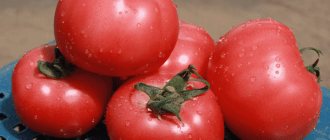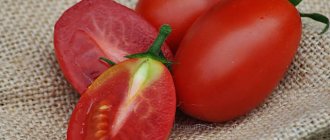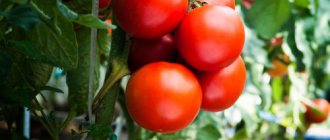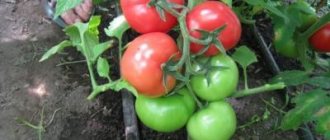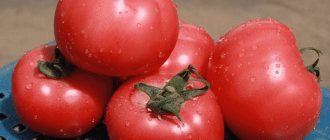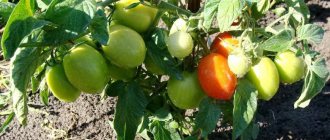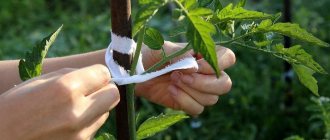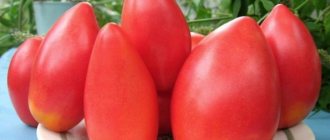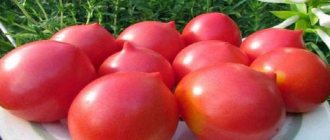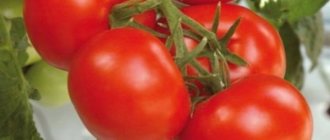The Yaki tomato is a Dutch hybrid, its correct name is Yaki F1. This is one of the ideal hybrid varieties for open ground; you can grow it both for yourself and in industrial quantities for sale.
| Height | Landing location | Ripening time | Fruit color | Fruit size | Origin | Fruit shape |
| short | Open ground | Mid-season | Reds | Average | Hybrid | Heart-shaped |
Description and characteristics of the variety
The Yaki F1 tomato bush type is determinate, reaches a height of 60-80 cm. The stems are strong and stable, the leaves are wide, medium in size, dark in color. Inflorescence of simple type. The first brush is formed above the 4-5th leaf. Tomatoes ripen on it in an average period - 100-105 days from the moment of germination. The following brushes develop at intervals of 1 leaf or even without it; in total, up to 12 of them are formed on the bush.
Yaki cream tomatoes are small, 85-150 g each, red in color and plum-shaped, slightly elongated. The pulp is dense and sugary, the taste is good for a hybrid. The fruits are suitable for making juices and pastes, as well as canning and fresh consumption.
Agrotechnics of cultivation
The best predecessors for growing a hybrid are winter grain crops, annual legumes, cucumbers, and cabbage. When choosing a method of growing in a permanent place without preliminary cultivation of seedlings, it is necessary that the soil warms up to +12 °C at a depth of 5-6 cm.
Sowing seeds for seedlings is carried out in mid-March. To do this, seeds are placed in special containers with prepared and moistened soil, covered with a layer of soil and film until the sprouts hatch.
Planting material is transferred to open ground after the end of the spring frost period. The recommended plant density depends on the cultivation conditions and varies from 2 to 7 bushes per 1 m².
When using the technology for obtaining a tomato harvest in open ground in the second rotation after early crops (onions, cabbage, potatoes), 35-45-day-old seedlings are planted at the end of June. The harvest takes place at the end of September.
See also
Description of the hybrid tomato variety Debut F1 and agrotechnical cultivation rules
Read
The productivity of the variety per 1 m² is 10-12 kg. To obtain the maximum yield, before planting, it is necessary to add 40-50 kg of organic fertilizers and 700 g of Nitroammofoska per 10 m² to the soil.
Most of the substances are applied in the fall, and the rest in the form of periodic fertilizing during the growing season. By the beginning of fruit ripening, to improve their quality, additionally use potassium (200 g) and ammonium nitrate (100 g) per 10 m².
During the growing season, 5-10 waterings are carried out using the drip irrigation method, which allows maintaining the balance of moisture and air near the root system. It is recommended to apply soluble mineral fertilizers with each watering.
Biological pests of tomato are the Colorado potato beetle, aphids, and cutworms. When using the seedling cultivation method, the plant is treated in solutions of special preparations before planting in the ground.
The most harmful diseases of the crop are late blight and black bacterial spot of tomatoes. In some years, the plant may be affected by stolbur. Elimination of disease carriers (leafhoppers) is carried out using insecticides.
What are the best early varieties of tomatoes to grow on the plot?
Tomato is a southern crop, accustomed to warmth and hot sun rays. To grow juicy tomatoes in the temperate Russian climate, it is better to rely on the best early-ripening varieties of tomatoes, which have a short growing season - 100-105 days. Such early tomatoes have time to grow and form full-fledged fruits.
Early of the Early
Recently, varieties with even shorter fruit ripening times have been developed. They began to be commonly called ultra-early, super-early or super-early. Here you will need to wait quite a bit. Just two and a half months after the seedlings emerge, the earliest varieties of tomatoes will delight the gardener with the first harvest of tomatoes. The most famous super-early tomato varieties: Aurora F1, Alenka, Bely Naliv, Big Momma, Zolotoy Stream, Labrador, Moscow Stars, President 2, Sanka, Bullfinch, Ultra-early F1, Yadviga F1 and others.
Tomato Jadwiga F1
One of the most prominent representatives of tomatoes with extremely short fruiting periods is Jadwiga F1. The Internet contains a lot of interesting information regarding the super-early hybrid Jadwiga F1. Here reviews of the Jadwiga F1 tomato praise the plant in every possible way. And this is easily explained: the variety is high-yielding, producing fruit even in the most unsuitable conditions. The ripening period of tomatoes ranges from 80 to 85 days, which also speaks in favor of the variety. The fruits ripen en masse, forming a harvest of large, non-watery vegetables, weighing 200-210 grams each. The pulp is strong, juicy and sweet. Ripened vegetables have good taste and excellent presentation. Round, glossy tomatoes with a bright red color are guaranteed to attract the buyer's attention. In more southern regions the plant can be grown without shelter. In cool climates, it is still advisable to use a “garden under glass”.
Tomato Shady Lady
A fairly common early variety is the Shedi Lady hybrid.
Increased amount of sugar and, as a result, a pleasant honey taste. The variety has no pronounced shortcomings, which is why gardeners love it.
Characteristics and description of the Shedy Lady F1 tomato are distinguished by the following features:
- a hybrid variety obtained by breeders from Holland;
- the variety is very early, the first fruits will appear on the plant on the sixty-eighth day after the start of active growth of seedlings;
- intended for greenhouses, as well as open ground;
- determinate bush, with limited growth, average plant height - seventy centimeters;
- well leafy, large bush;
- high productivity (7.5 kg/sq.m.);
- drought-resistant variety, has increased immunity to diseases;
- Removing stepsons is a necessary element of plant care.
The fruits of the Shedi Lady variety are bright red, collected in clusters of 3-4 pieces. Each tomato weighs about 200 grams. The shape resembles a slightly flattened ball. This variety is designed for fresh use, since it is included in the salad group of tomatoes. Shady Lady tomatoes will make wonderful juice, tomato puree, juicy and aromatic salads, and creamy soups (for example, gazpacho).
Tomato Yamal 200
Reviews of the Yamal 200 tomato, which also belongs to varieties with early fruit formation, contain commendable characteristics.
The growing season lasts 103-108 days. But it is possible to achieve an earlier yield of the crop - 95-97 days after the seedlings emerge. A greenhouse will help you get these “fast results.” By the way, thanks to its compact size - 35-40 centimeters in height, the plant is best suited for greenhouse cultivation. In addition, “stocky” bushes do not need to be supported, and they do not require pinching. The main feature of the Yamal 200 variety is the long harvest time. Moreover, the fruits are formed continuously, not paying attention to even the most unexpected vagaries of the weather. Yamal 200 tomatoes are round, flattened, rich red in color. The weight of tomatoes is average (70-80 grams). The first tomatoes will be larger - about 115 grams. Tomato Yamal 200 is distinguished by the constant production of fruits of standard sizes. The taste of the vegetable is good. The yield is also quite good - about 5 kg/sq.m.
The variety is salad, so it will become an indispensable ingredient in all kinds of salads. But it is quite often used for canning whole tomatoes.
Tomato Yaki F1 - a productive variety of small stature
The Dutch hybrid Yaki F1 is a worthy representation of early, low-growing tomatoes.
This tomato is designed for growing without greenhouses. Small, stocky bushes with powerful stems do not need to be cut off. The litter is intended for open ground, and is planted with seeds or seedlings. The growing season is 65-70 days. Shows commendable resistance to garden diseases and produces a good harvest. The bushes are literally covered with red tomatoes. Medium-sized fruits weigh 85-100 grams. The shape is elongated, similar to a plum, which is why this variety is often called “plum”. Numerous reviews of the Yaki F1 tomato claim that it is best to use this variety for canning and making thick tomato paste. But fresh, ripe cream tomatoes will also delight you with their juicy pulp and wonderful aroma.
Tomato Shakira F1
Leaving reviews about the Shakira F1 tomato, domestic farmers express their admiration for the extraordinary fertility of the variety.
One square meter planted with Shakira F1 tomatoes produces about nine and a half kilograms of fruit of excellent quality. A mid-early plant of Dutch selection, it grows better in covered soil conditions, but also shows good results when grown without film cover. The bushes are indeterminate, tall, two meters, powerful. The Shakira F1 variety ensures a good harvest with large fruits. One tomato weighs 300-400 grams, flattened and round, juicy, red in color. The taste is pleasant, the aroma is delicate. Used for any culinary dishes that include tomatoes in the recipe.
Tomato Shiva F1
The Shiva F1 variety is considered a newcomer among early-ripening tomatoes. The fruits have time to ripen within 90 days from the beginning of the growing season. The early ripening of vegetables is also confirmed by reviews of the Shiva F1 tomato on country forums. According to the type of growth, Shiva F1 is a determinate hybrid.
Review of tomato variety F1: characteristics and yield
What are these tomato varieties with the ending F1? In this way, hybrid tomatoes specially bred by breeders by crossing other varieties are marked. Scientists have worked hard to ensure that newly created plants have the best qualities of their ancestors. As a rule, hybrids have good characteristics - they are resistant to many diseases, are not afraid of cold weather, and are undemanding to soil fertility.
Features of hybrid tomatoes
F1 varieties can belong to a low-growing species, a tall one, and may have different ripening periods. The characteristic indicates the different size, color and weight of the fruit. For sale to summer residents they offer a wide variety of hybrids, for every taste and for any purpose - these are red and orange tomatoes, small and large, for pickling and for fresh consumption. Characteristics and descriptions of F1 tomato varieties indicate the properties of a particular variety.
The main feature of hybrids is that the seeds obtained from the harvest cannot be used for sowing seedlings for the next year. Seeds of hybrid tomatoes retain the attractive properties of their parents for only 1 season. Next season, no one can guarantee that a vegetable with the same properties will grow from the seeds of tomatoes collected on the plot. Every year you need to buy new hybrid seeds from a specialty store.
Breeders note that the greater the difference in characteristics between the tomato varieties being crossed, the stronger the hybrid can be obtained.
The main advantages of hybrid varieties are as follows:
- resistance to common vegetable diseases and pests;
- undemanding to the growing soil;
- early fruit ripening;
- increased productivity.
Hybrid varieties may be somewhat inferior to pure tomatoes in terms of fruit taste, but this drawback is not too noticeable.
Which hybrid varieties to choose?
In the conditions of central Russia, it is better to grow tomatoes in a greenhouse. The following hybrid varieties are recommended for cultivation:
- VerliokaF This is a tall early variety. Its fruits are suitable for use in culinary dishes and for winter preparations. The fruits have a classic round shape, bright red color, and weigh up to 100 grams. The characteristic also notes the disadvantage of the variety - the demands of tomatoes on the composition of the soil and the need to periodically feed the plants with fertilizers. In cool weather, warm the water until warm before watering.
Search companies have known F1 varieties for a long time. She successfully sells hybrid seeds in specialized stores and large supermarkets. Characteristics and descriptions of F1 tomato varieties can be found on the package with seeds. The photo shows fruiting bushes of hybrid tomatoes. In reviews, experienced gardeners advise which varieties of tomatoes are best to plant in certain climatic conditions.
| average | ||
| 5 | tomato nematode | high |
